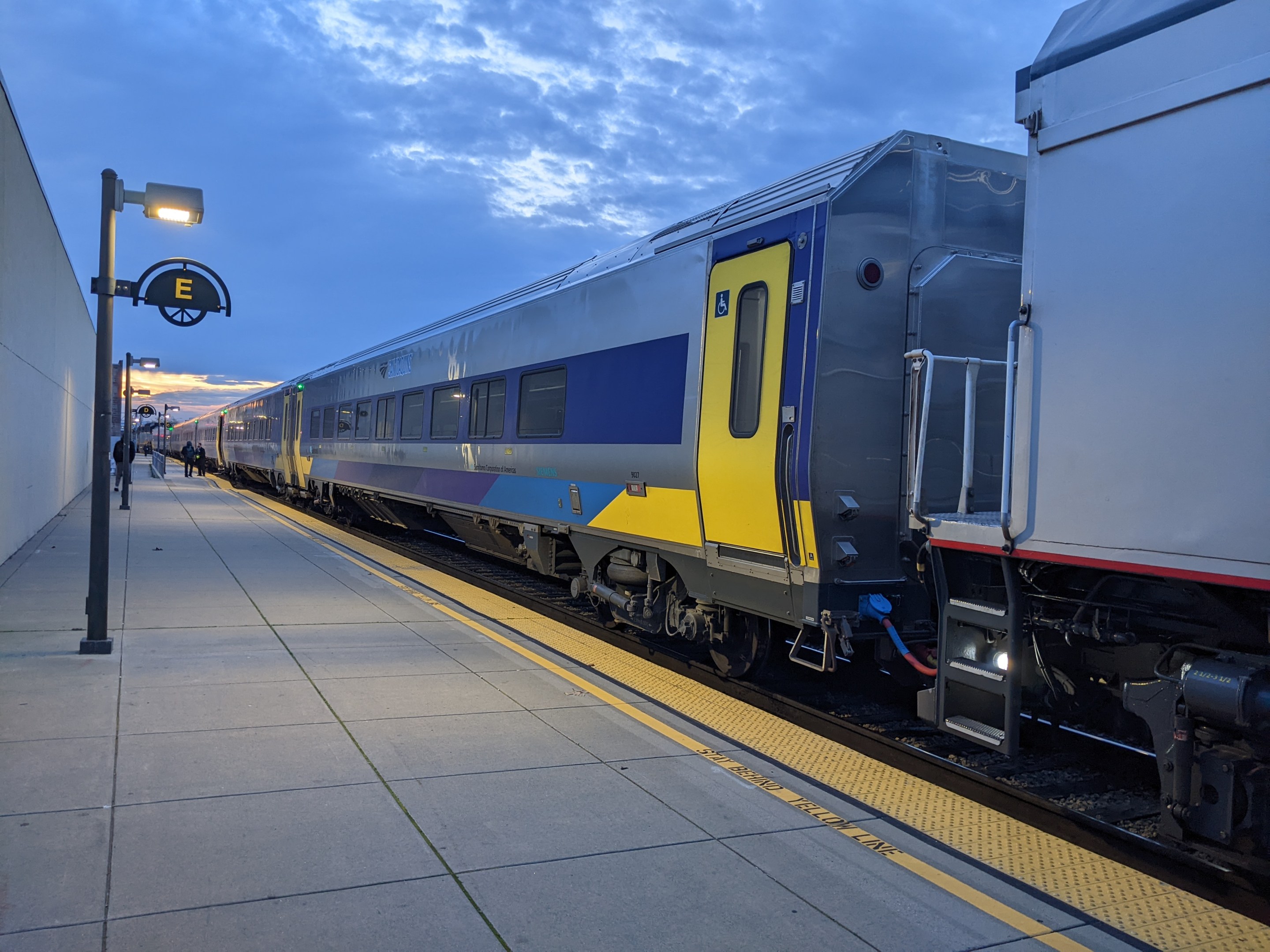Note: GJEL Accident Attorneys regularly sponsors coverage on Streetsblog San Francisco and Streetsblog California. Unless noted in the story, GJEL Accident Attorneys is not consulted for the content or editorial direction of the sponsored content.
New train cars started rolling on Amtrak's San Joaquin, the state-supported service that connects Oakland and the Central Valley, just before the Christmas break. Unfortunately, Amtrak passengers on these cars discovered they had nothing to eat.
But more on that later.
It's worth noting that the roll-out of the new "Venture" cars pictured in the lead image was done with no fanfare. BART worked hard to publicize its roll-out of the "fleet of the future." Caltrain invited the press and the public on multiple occasions to view its new Stadler electric trains in San Jose and San Francisco. But Amtrak only held a joint press-conference for the new trains with Siemens, the manufacturer, at their plant 13 miles from Amtrak's Sacramento station. There was no public launch.
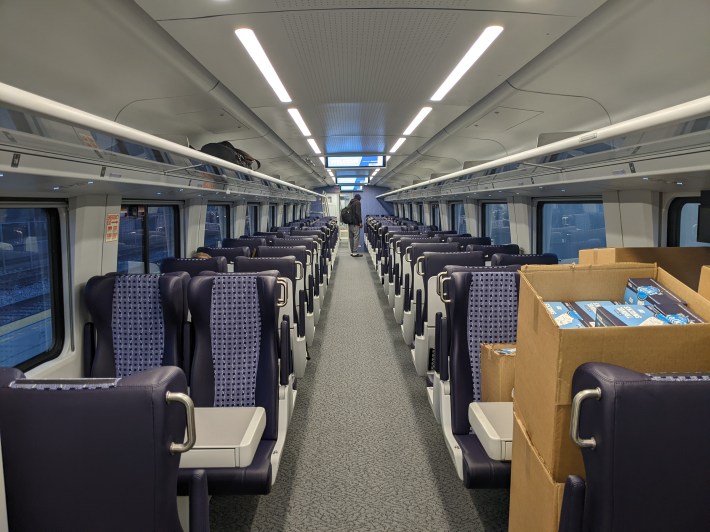
I only found out the new trains were in service -- on one early morning southbound run from Oakland to Bakersfield and one late evening return -- via social media.
I took a ride on the 7:36 a.m. train, and got off at Martinez at 8:25, just to try them out. Compared to the bi-levels they are replacing, they are more brightly lit, with high ceilings. There are nice, wide passageways between the cars. They're also quieter, with a smoother ride. And there are easily accessible AC and USB plugs between every seat.
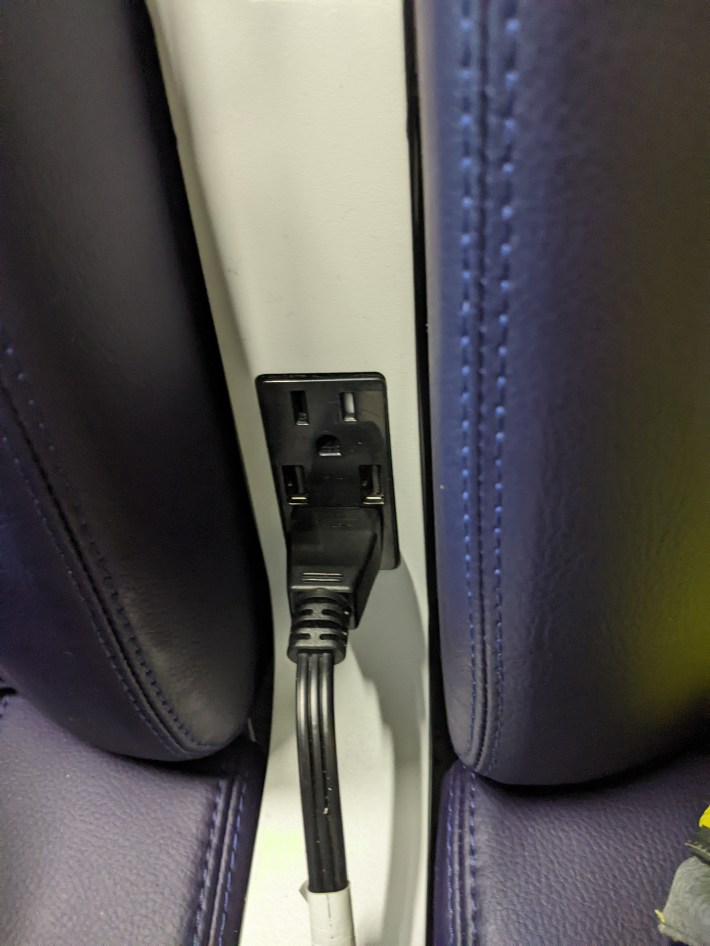
There are bike racks at the ends of every car. They're supposed to hold three bikes each, but I doubt they really could, as the space between the hooks doesn't seem sufficient. Moreover, my bike fell out when the train stopped. The racks on the older trains have a retractable arm with a bracket you can Velcro to your pedal cranks to keep your bike steady. The new racks really need a strap to keep bikes from swaying and swinging into each other and out of the hook.
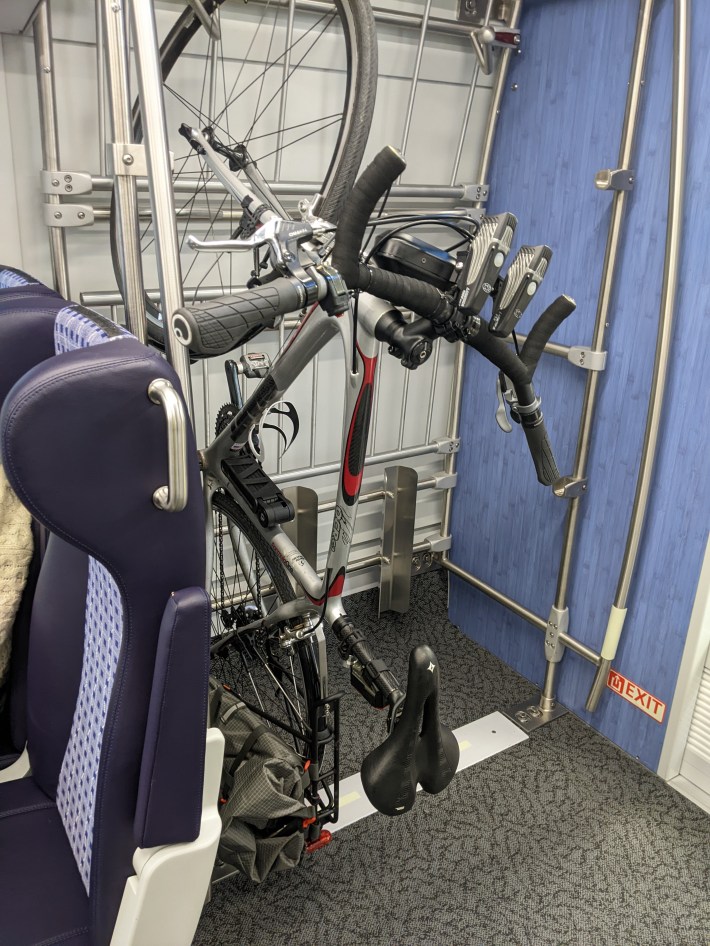
The new seats are firm and comfortable, but bizarrely narrow. I didn't have anyone sitting next to me, by if I centered my body in the seat my shoulder was partially in the seat next to me. There's also only a single, narrow arm rest between the seats. When the train is packed (and I ride them enough to know they do get packed, especially on weekends and around the holidays), medium-to-large people will literally be rubbing shoulders.
"The narrower seats provide for wider aisles that can be comfortably navigated by a wheelchair user. This feature along with the automatic doors and accessible vestibule area allow for passengers in wheelchairs access to the entire trainset," wrote the San Joaquin's David Lipari, in an email to Streetsblog. "The San Joaquin Joint Power Authority (SJJPA) and Caltrans have prioritized this sort of access as it is in line with our mission to provide access to as many Californians as possible." (Two cars per trainset will have built-in wheelchair lifts for boarding).
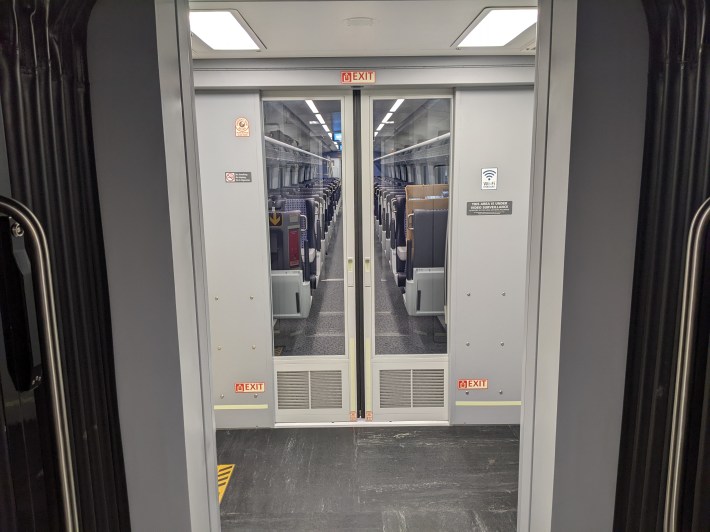
The older trains accommodate wheelchair-bound patrons by keeping the wheelchair seating area near the accessible bathroom. As to accessing the rest of the train, where is someone in a wheelchair -- or not in a wheelchair -- going to go?
Well, the cafe car of course. Which brings us back to the food issue: there is no cafe car.
Keep in mind someone riding end-to-end, from Jack London Square to Bakersfield, will be on the train for six and a half hours. Many people in Bakersfield connect to a bus to Los Angeles and other Southern California destinations.
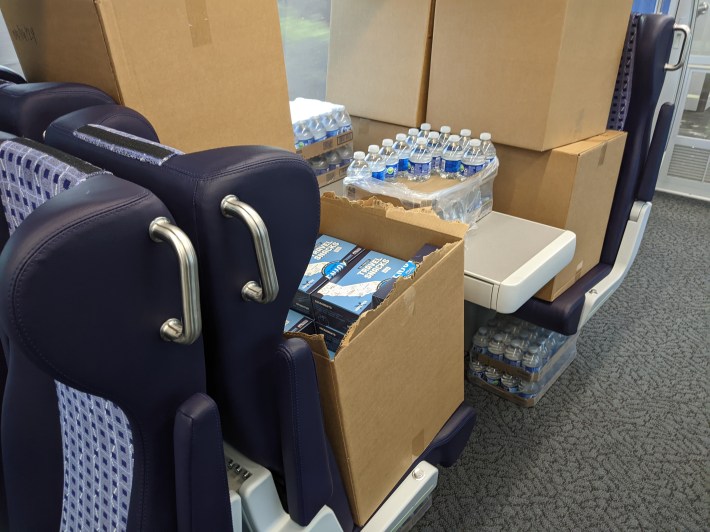
That means one could be traveling for over nine hours, assuming the train and connecting buses are on time, without any way to buy food.
"The Venture Cars are being phased into operation with certain car types entering into service ahead of others. One of the final car types to be deployed will be Vending Cars, each of which will include vending machines," explained Lipari.
That's a significant downgrade from the full-length cafe cars that currently run on the older San Joaquin trainsets. That car offers drinks, coffee, and a range of food.
Amtrak still has the full menu online, until recently with no indication that its two new-train runs offer no food. They added "Note: There is currently no Cafe Car service on trains 710/719 [the trains that use the new Venture cars]. Passengers can get complimentary snacks and water," in the last week, probably because I asked about it as part of researching this story.
On my train, several people, some with families, were just finding out that all they could expect was an Amtrak snack box with a bag of chips, some cookies, peanuts, and a granola bar (also with peanuts, the most common food allergy).
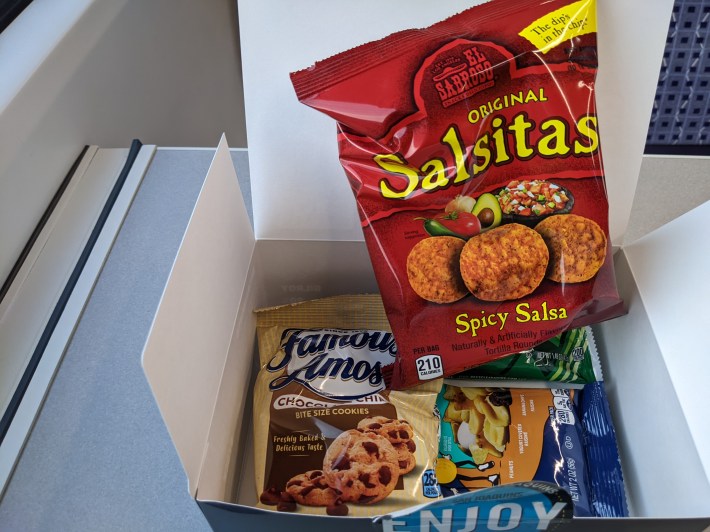
I really feel for a Bay Area family going to see grandma in Bakersfield on this train.
Jim Mathews, President and CEO Rail Passengers Association, an advocacy group based in Washington D.C., told Streetsblog that they cautioned SJJPA against ordering new trains without a cafe. "Their question to us was, essentially, 'will people be enraged by this decision?' Our advice at the time was, well, yes."
He said the SJJPA countered that most people don't ride the train end-to-end and that they could cut costs by instead installing vending machines with "pre-packaged sandwiches, healthy snacks, etc."
"It seems they chose to downgrade service for people on that route rather than offer the same service they would offer elsewhere in the state," he added. Dennis Lytton, another rail expert and independent advocate, gibed that having no coffee or even soda on the current train is tantamount to an "act of war and probably a violation of the Geneva Convention."
"Like travel on airlines, bringing personal food and beverage items onboard is allowed," wrote Lipari. Except that even airlines offer food for purchase, at least, on flights over a couple of hours.
Another issue: the trains have automatic doors and stairs. However, on my trip to Martinez, Amtrak used only two doors on the entire train and made everyone line up to board and disembark, increasing train dwell times at stations.
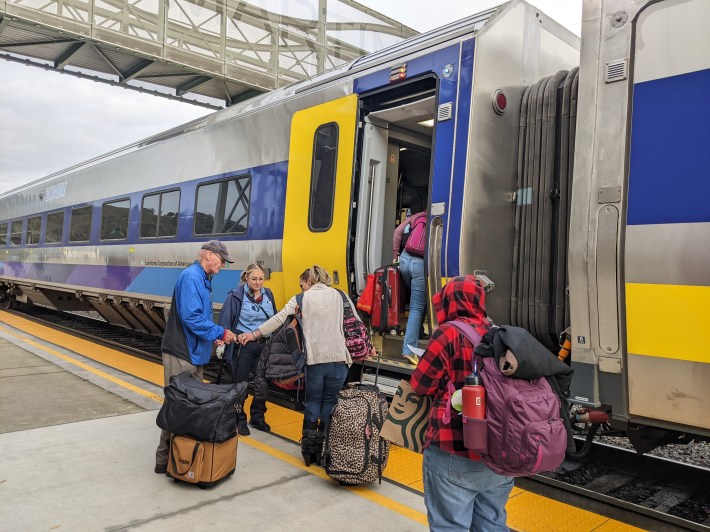
Apparently, this is a leftover procedure from some of their very old, antique high-floor equipment. The oldest trains in the fleet have manual "traps" that cover the stairs. A train employee is required to open doors, manually lift the trap, and put a step stool down on the platform to help passengers get on and off. The new trains are fully automatic (see image below of the stairs that drop down from underneath the car), but Amtrak continues to require an employee to stand by any open door. "The SJJPA is focused on getting this resolved quickly to speed boarding and deboarding which is meant to be one of the key features of these cars," wrote Lipari.
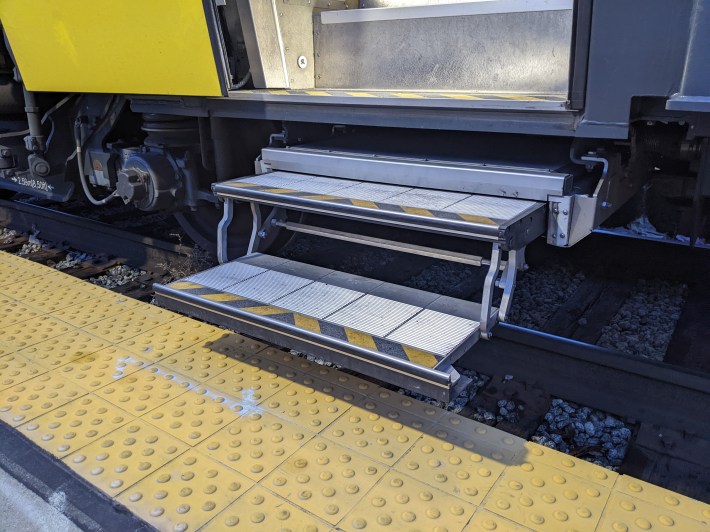
California's new Venture cars are essentially the same as the Amtrak Venture equipment getting rolled out in the Midwest and elsewhere. It makes sense for Amtrak's California-supported trains to standardize with equipment used in the rest of the country (also, they really didn't have any choice). Siemens is a solid car builder and these trains should be reliable. But the decision to eliminate the cafe car is penny wise and pound foolish. Yes, it saves paying the salary of a cafe attendant, but a highlight of taking the train is heading down to the cafe car for a coffee, snack, lunch, or a beer. And while the vending machines may solve some of this, leaving nothing but snack boxes in the meantime is unacceptable. And no coffee? How hard is it to clear some space and put in a coffee machine?
The Capitol Corridor, the other California-sponsored Bay Area Amtrak service, has no plans to get rid of food and drink services and for now is planning to overhaul its existing, bi-level coaches and cafe cars. Ironically, the Capitol Corridor runs trains on much shorter trips than the San Joaquin (the longest run is a little over three hours, from San Jose to Sacramento). But, as the name implies, these trains carry lawmakers between the Bay Area and the Capitol. Lawmakers and their staffs would be none-too-happy to find out they can't buy a coffee on the way up to Sacramento or a beer on the way back.
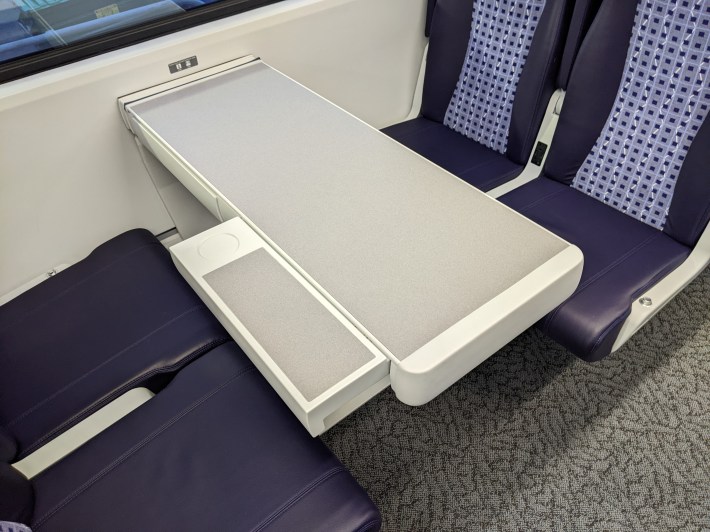
The decision to use such narrow seats is also a mistake. Yes, everyone wants people in wheelchairs to have as much access as is practical. And previous generations of trains left something to be desired, mostly because the cafe is on the upper level, and there's no elevator, so they had no way to reach it. But the solution is to retain a cafe on these new trains, put the wheelchair seating next to it, and keep the area around it with wider aisles, perhaps with three-across seating to make room. Installing tiny seats throughout the train is just an over-the-top solution that's going to make the train unpleasant for everyone when it's crowded.
My takeaway is that the people who run the SJJPA can't possibly be taking the train as frequently as they should (if at all) to understand passenger needs. Chips, granola bars, and water? On a trip that takes over six hours? Anybody and everybody who let that happen are in the wrong business.
